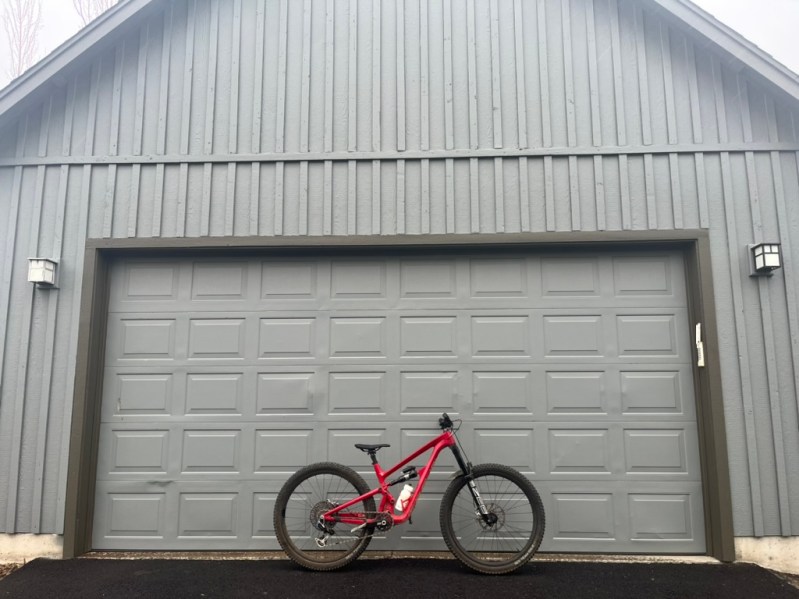
For many of us living in the northern part of the country, the winter season can mean time away from mountain biking. Mountain bike trails are often under snow for several months, and even if they aren’t, the trails can be too wet and sloppy to ride.
But just because the trails need some time to thaw out doesn’t mean you can’t work on some critical mountain biking skills. And you don’t need to travel far to practice these skills—your driveway will do.

Track stand
While track stands may be more common amongst road cyclists and commuters, they are absolutely a skill transferable to the mountain bike world.
Track stands are when you can balance your bike—in our case, your mountain bike—completely stopped without putting a foot down. These are the features track stands help you on the trail:
- Technical, rocky trails
- Technical climbs
- Tight corners
- Anywhere you may need to adjust the mountain bike but keep your feet on the pedals
This can be especially helpful if you mountain bike with clipless pedals and shoes. Track stands allow you to stop, adjust, and tackle the next technical trail section. But before you can do this on a chunky trail somewhere, it’s an easy skill to learn in your driveway.

Front-wheel lift
Unless you are only riding at bike parks, you will have to do some climbing on your next mountain bike ride. And, actually, climbing can be pretty fun, especially when climbing more technical trails.
But, to feel the satisfaction of conquering challenging climbs, you must know some basic mountain bike climbing skills. The front-wheel lift is one of the first skills you should learn in mountain biking.
The front-wheel lift will help you:
- Get over obstacles (rocks, roots, small logs) on flatter sections of trail at lower speeds
- Carry momentum over obstacles while climbing
There are a few different ways you can practice a front-wheel lift on your mountain bike right out your front door. Curbs work great as an “obstacle” and mimic the feel of a rock shelf on a trail.

Rear-wheel lift
Learning a front-wheel lift on your mountain bike isn’t helpful if a rear-wheel lift doesn’t follow it. Running your rear wheel into that shelf can destroy all that momentum you carry by doing a proper front-wheel lift up a rock shelf.
The rear-wheel lift will help you with the same things the front-wheel lift helps you with, just the back of the mountain bike.
Stick to the curb you’ve been practicing the front-wheel lift on. Now, instead of letting your rear tire roll up and over the curb as it follows the front, put weight on the front of your bars and try to pull that rear wheel toward you.

Stoppie
This is the one that will impress all your mountain biking buddies. A stoppie is when you grab a handful of front brakes, stopping as your mountain bike rides only on its front wheel.
Other than looking really cool, there are some practical reasons for using a stoppie on the trails.
- The front brakes = the majority of speed reduction. A stoppie can help you stop fast, but you must learn how to use it properly without flipping over the handlebars.
- You can get into position on the trail by pivoting on your front tire. This is especially helpful when repositioning in tight places.
- The ultimate skill is ditching the track stand in tight corners and learning to descend tight switchbacks using a stoppie.
Any bit of driveway or empty road will do. When practicing stoppies, the key is to start small. As you gain confidence, you can practice going faster and using more front brakes.

Skinnies
Skinnies are wooden structures, typically made from fallen logs, that you can mountain bike on. If you can imagine mountain biking on a fallen log, you can probably guess where the name “skinny” came from.
Once again, a curb along a sidewalk is a great place to practice skinnies. Set a goal of trying to ride from one driveway to another. If you don’t have sidewalks and curbs where you live, riding on 2 x 4 lumber is a great alternative.
Practicing skinnies will help with:
- Overall balance
- Confidence in an actual skinny out on the trails
- Keeping a line on narrow bits of trail
Winter mountain bike woes
Unfortunately, for many riders, winter means a time to hang up their mountain bike and wait for the spring to thaw. If that is you, what have you been up to? Let me guess, you have:
- Meticulously cleaned your mountain bike…check.
- Handled any significant maintenance needs…check
- Clicked “Buy” on several component upgrades…check
And now your mountain bike just sits in your garage, waiting to get back out there.
Stop waiting, shovel your driveway, and get out there and practice these skills. And just to be clear, track stands, wheel lifts, stoppies, and skinnies aren’t the only skills you can practice at home.
Practicing these skills off the trail makes springtime mountain biking much easier once the snow melts.
Editors' Recommendations
- Every rider should know these mountain bike climbing basics
- Dust off your gear, it’s time to hit the trail: The spring hiking tips you need
- Garmin, Seiko, G-SHOCK, and more: Our picks for best outdoor watches in 2024
- Why you can’t depend on first-come, first-served campgrounds this summer
- 3 lesser-known tips that can save your life on the trail




